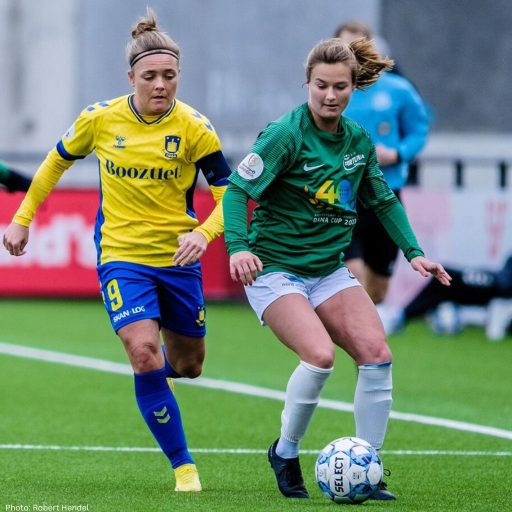Women's Soccer Fitness Tips
for High School, College to Pro
Kickoff
As a recent graduate from U.N.C. and joining a new professional women’s soccer player in Europe, I can attest that transitioning from training to playing professionally is no easy feat.
It’s filled with many trials and tribulations. However, one constant I’ve found is that maintaining an unwavering focus on fitness often makes the difference between good and the best.
In soccer, fitness is a game-changer. It dramatically impacts performance, incorporating a combination of speed, agility, endurance, and mental resilience.
The optimization of these elements is critical for any player who wants to reach her full potential.

Fitness and Its Impact on Performance and Injury Prevention
Fitness is at the heart of performance in soccer. It enhances critical skills like sprinting, quick directional changes, and maintaining energy throughout the game. As a professional player, you need to manage fatigue to focus on the game’s technical and tactical aspects.
Being fit lets you concentrate on your next pass or movement, enhancing your performance. But fitness isn’t just about improving performance; it also plays a role in injury prevention.
Injuries are quite common in soccer. However, a fit player is better equipped to resist injuries as the strength and endurance prepare your body to withstand more.
It’s crucial to sustain your strength during the season with low-rep, low-weight exercises. Warming up properly becomes even more vital in preventing injuries as you age and compete at higher levels.
Fitness also directly affects recovery speed. At the collegiate and professional levels, quick recovery is essential.
Players with high fitness levels recover faster after games, ensuring they are match-ready in a shorter time span and reducing the risk of injury. You need to be able to train after one off day to prepare for the upcoming games.
Effective Training Techniques for Soccer Fitness
To maximize fitness, you must use the proper training techniques. I’ve found the following methods to be particularly helpful in boosting speed, agility, and endurance.
Interval Training
Interval training is an excellent technique to boost cardiovascular fitness and stamina. This approach alternates between high-intensity and low-intensity exercises, optimizing energy use and recovery.
One endurance interval run I like to do is a two-mile run, alternating speeds every 0.1 mile. A typical run would consist of a sprint for 0.1 miles followed by a jog for 0.1 miles, then alternating for the remainder of two miles.
This technique increases endurance as you have to recover on a jog, similar to recovery in an actual game. This technique models recovery on the move after repeated sprints.
Plyometric Drills
Plyometric drills serve as a fantastic method for amplifying explosive power, a crucial component for accelerating and sudden changes in direction.
Actions such as jumps and hops can have a remarkable impact. They contribute to enhancing your agility and explosiveness, elements that are highly significant for soccer players.
Boosting the explosiveness of your initial few steps can provide a substantial edge over your opponent. Plyometric drills also aid in accelerating your start and stop speeds, which can be a game-changer for beating players off the dribble or defensive reactions.
Examples of such exercises are hurdle jumps for stability and speed or height enhancement, ladder drills for quick footwork, mirroring a partner to improve reaction speed, box jumps (single or double leg variations), lateral jumps and advanced barbell jumps when you are ready.
Strength Training
Regular strength training is a crucial aspect of fitness for soccer players. It bolsters overall power and endurance, ensuring you remain sturdy and unfaltering throughout a 90-minute game.
A solid strength foundation is essential in preventing injuries, an important consideration for women’s soccer. Some effective lower-body exercises that maintain strength without causing overuse injuries include split squats with dumbbells, hamstring curls, Copenhagens, and banded exercises.
I typically lean towards heavier upper body workouts during both in and off-season periods as they enhance my overall strength. During the off-season, you can increase the weight in lower body exercises, incorporating routines like front or back squats, deadlifts, or step-ups.
As a general guideline, doing strength training about three times a week in the off-season and twice during the season is beneficial.
Agility Training
On the soccer pitch, agility can often be the key to outplaying your opponents. You can integrate agility training tools such as ladders or hurdles into your routine to improve in this area.
Drills that involve quick cutting or changes in direction are advantageous for enhancing agility. One of my preferred agility training techniques is the 5-10-5 drill, which focuses on changing direction in a confined space.
To execute this drill, place three cones in a straight line, each ten yards apart. Start from the middle cone, sprint 5 yards to one end, turn, and run for a full 10 yards to the other end, then sprint back to the middle cone for the final 5 yards.
Endurance vs. Agility Training
It’s important to understand the differences between endurance and agility training. Both are crucial for soccer, but training for them can sometimes be counterintuitive.
For endurance, you need to run longer distances at a slower pace, whereas for agility, runs are shorter but faster, which could negatively affect endurance. To improve in one, you may remain at a standstill in the other.
It’s important to know how these two trainings interact together not to be frustrated if you don’t see development in one of them while trying to improve both.
Mastering the S.M.A.R.T. Approach,
Setting Effective and Achievable Fitness Goals
One of the foundational aspects of a successful fitness journey is the ability to manage expectations, which often starts with setting attainable goals.
A recommended strategy is to structure your goals around the SMART principle, which stands for Specific, Measurable, Achievable, Relevant, and Time-bound.
Understanding that progress takes time and consistent effort is crucial, and quick-fix results are rare. Small, gradual advancements are vital to observing accurate, sustainable results.
Specific
Specific refers to establishing clear parameters, such as a defined time or distance. For instance, in the interval two-mile run I mentioned earlier, the rule to increase speed every 0.1 mile gives you a specific framework to follow.
Measurable
Measurable denotes that a mechanism must be in place to track your progress. Using the same example, you can measure your progress by timing the run and aiming to shave off a few seconds each time you complete it.
Alternatively, in a different kind of workout, you could work on decreasing the rest time between sets.
Achievable
Achievable is an important principle because it guides you to set goals that are within reach yet still challenging. It demands honesty in evaluating your current fitness level, allowing room for growth and improvement without setting unrealistic expectations.
Relevant
Relevant goals ensure that the training is game-realistic and specific to your position on the field.
For instance, running straight 120s may not be the most effective training style as a forward. Such a regimen might be more beneficial for an outside back or a box-to-box midfielder.
It’s crucial to vary the type of running workouts, sometimes aiming for longer endurance runs and at other times executing shorter sprints with a lot of direction changes since both are game-realistic.
Time-bound
Time-bound is vital as it’s usual to have a specific date by which you need to reach your fitness level, typically the start of the season.
Formulating a plan that progressively works towards your goal each week leading up to the beginning of the season can be beneficial.
This approach should provide a clear roadmap to help you reach your goal in a structured and timely manner.
The Power of Positivity, Perseverance and Self-Reflection
Adopting a positive mindset can be a game-changer in maintaining your motivation, mainly when progress seems to be slow. Engaging in regular positive self-talk, celebrating every small victory, and immersing in self-reflection can help uphold a productive attitude.
Remember, the journey of fitness and soccer is a steady climb of incremental progressions. It’s tempting to expect leaps in progression after just a couple of weeks of intense effort, but the reality is that steady, incremental progress lays the foundation for long-term success. Just think about getting 1% better in one area each day.
Accepting that only some days will yield the desired results is important. Sometimes, you might miss your milestones or experience setbacks. But remember, the essence of the journey lies in the effort you continue to put in consistently, irrespective of the immediate outcome.
Remember, it’s nearly impossible to maintain a 100% perfect performance all the time. It’s this understanding that encourages patience with yourself. If you feel you’re not where you want to be, the key lies in maintaining a consistent work ethic and setting transparent, achievable goals. Over time, persistence and patience will guide you to your desired destination.
Keeping track of your progress can be an incredible motivator and a tool for identifying areas that need improvement. There are many progress-tracking apps out there that can help you with this. When faced with setbacks, seeing them as learning experiences and stepping stones toward your final goal rather than insurmountable hurdles is essential.
Recording daily activities, including run times, distance, and ball work, can provide a valuable record of your progression and highlight areas that need further effort. Seeing your shortcomings on paper can be disheartening, but using those areas as motivation and keeping your end goal in sight can drive you forward.
Remember, the path toward your goal will sometimes take work. Setbacks are inevitable. However, with consistent progress tracking, an unwavering focus on your end goal, and a positive mindset, you can overcome these challenges and continue your journey to success.
Rest and Recovery to Build Mental Resilience
Rest and recovery form an integral part of nurturing mental resilience. A well-rested body enhances your mental strength, allowing you to perform best, concentrating on the present rather than being hampered by fatigue or bodily discomfort.
Regular exercise with a healthy diet and sufficient sleep contributes significantly to mental resilience. Fueling your body correctly is crucial for optimizing your training and enabling you to concentrate.
When your body is well-nourished, you can dig deeper, push harder, and tap into reserves that propel you toward your goals. Sleep, often overlooked, is when your brain recharges. Aim for 8-10 hours of sleep for full brain recovery and rejuvenation.
Starting your day with a well-rested brain enhances your alertness and sharpens your focus on your goals. Always remember taking care of your physical health is essential in your quest to achieve your soccer dreams.
Dealing with Setbacks in Fitness Goals
Setbacks should be embraced as a fundamental part of achieving fitness goals. Rather than letting them deter you, analyze and learn from them, using these lessons as stepping stones to reach your ultimate goal.
Remember, the essence of resilience is bouncing back stronger than before. Fitness improvement isn’t an overnight phenomenon – it doesn’t just escalate after one week or one session.
Staying consistent and trusting the process is crucial to achieving tangible results. With patience and determination, your efforts will yield the results you aim for.
The Role of Consistency in Women's Soccer Fitness
Consistency is the linchpin in any fitness regimen, especially in women’s soccer. Regular, disciplined training conditions the body for enhanced performance and swifter recovery, paving the way for gradual and steady improvement.
In women’s football, fitness and strength significantly determine success. It’s vital to reach your peak fitness level during the preseason, sustain it throughout the season, and prevent deconditioning during the off-season. This approach ensures that your progress isn’t hindered and that you’re always ready for your next challenge.
The Technical and Tactical Aspects of Soccer
Performance in soccer goes beyond physical attributes. Tactical and technical understanding of the game is equally important. You can balance your physical training with understanding game strategy, individual skills, and team dynamics.
Watching professional games, discussing strategies with your teammates and coaches, and constantly learning are all integral parts of becoming a complete player. I’ll discuss this topic in more detail in an upcoming article.
The Value of a Strong Support Network
Your journey as a professional soccer player will require a strong support network. Surround yourself with people who understand your commitment and goals and can provide the emotional and logistical support you need. This includes family, friends, coaches, physiotherapists, and fellow players.
Teamwork in Soccer
In soccer, teamwork is key. Your skills and teamwork are crucial for success. Build strong bonds with teammates, trust and support each other on the field, and value their input.
Handling Pressure and Criticism
It’s crucial for you to learn how to handle pressure and criticism. The higher the level you play, the more scrutiny you will face from coaches, fans, and the media.
Constructive criticism is crucial for growth, so don’t shy away from it. However, developing a thick skin to filter out unfair criticism is equally important.
Keeping the Love for the Game Alive
Never forget why you started playing soccer in the first place. It’s easy to get caught up in pursuing success and lose sight of the joy and passion that initially drew you to the game.
Remember to enjoy every practice and game, and when things are not going as planned, take a step back and remember why you love the game.
Final Whistle
Every soccer player’s journey has highs and lows, but our dedication to fitness and love for the game unites us. From UNC-Chapel Hill to Shelbourne FC, I’ve learned the value of consistency, resilience, and growth.
Fitness is more than just physical preparation; it’s a testament to our dedication, discipline, and determination.
Whether you’re starting in soccer or going pro, I hope these tips bring you closer to reaching your goal at whatever level you strive to obtain.
Stay committed, stay fit, and always keep the love for the game alive. All the best for your soccer success, Sincerely, Libby

Libby Moore
Meet Libby Moore, hailing from Wilmington, North Carolina.
She now plays for Shelbourne FC in Dublin, Ireland, after a stint with Fortuna Hjorring in Denmark. Libby graduated from UNC-Chapel Hill in December 2022 with a major in Global Studies and minors in Spanish and Neuroscience.
As a scholar-athlete, she played for the nationally-ranked UNC Tarheels women's soccer team. Her varied academic and sports backgrounds provide a distinct viewpoint on the move from collegiate to professional soccer.
She also serves as an Ambassador and Mentor for Soccer Talented, committed to nurturing and guiding the upcoming females in the soccer world.


